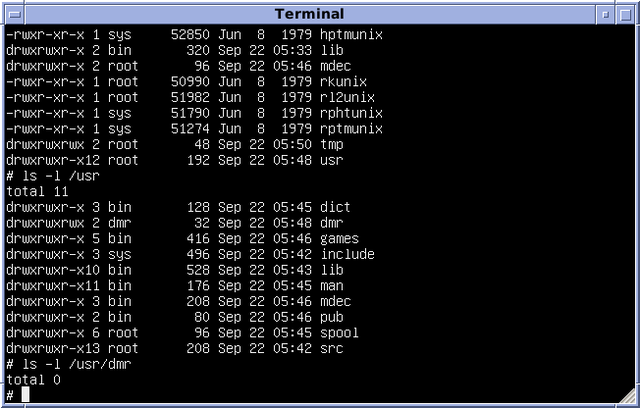Top Qs
Timeline
Chat
Perspective
Research Unix
Original Unix operating system from Bell Labs From Wikipedia, the free encyclopedia
Remove ads
Remove ads
Research Unix refers to the early versions of the Unix operating system for DEC PDP-7, PDP-11, VAX and Interdata 7/32 and 8/32 computers, developed in the Bell Labs Computing Sciences Research Center (CSRC). The term Research Unix first appeared in the Bell System Technical Journal (Vol. 57, No. 6, Part 2 July/August 1978) to distinguish it from other versions internal to Bell Labs (such as PWB/UNIX and MERT) whose code-base had diverged from the primary CSRC version. However, that term was little-used until Version 8 Unix (1985), but has been retroactively applied to earlier versions as well. Prior to V8, the operating system was most commonly called simply UNIX (in caps) or the UNIX Time-Sharing System.
It has been suggested that Ancient UNIX be merged into this article. (Discuss) Proposed since December 2024. |
Remove ads
History
Summarize
Perspective

AT&T licensed Version 5 to educational institutions, and Version 6 also to commercial sites. Schools paid $200 and others $20,000, discouraging most commercial use, but Version 6 was the most widely used version into the 1980s. Research Unix versions are often referred to by the edition of the manual that describes them,[1] because early versions and the last few were never officially released outside of Bell Labs, and grew organically. So, the first Research Unix would be the First Edition, and the last the Tenth Edition. Another common way of referring to them is as "Version x Unix" or "Vx Unix", where x is the manual edition. All modern editions of Unix—excepting Unix-like implementations such as Coherent, Minix, and Linux—derive from the 7th Edition.[citation needed]
Starting with the 8th Edition, versions of Research Unix had a close relationship to BSD. This began by using 4.1cBSD as the basis for the 8th Edition. In a Usenet post from 2000, Dennis Ritchie described these later versions of Research Unix as being closer to BSD than they were to UNIX System V,[2] which also included some BSD code:[1]
Research Unix 8th Edition started from (I think) BSD 4.1c, but with enormous amounts scooped out and replaced by our own stuff. This continued with 9th and 10th. The ordinary user command-set was, I guess, a bit more BSD-flavored than SysVish, but it was pretty eclectic.
Remove ads
Versions
Remove ads
Legacy
In 2002, Caldera International released[12] Unix V1, V2, V3, V4, V5, V6, V7 on PDP-11 and Unix 32V on VAX as FOSS under a permissive BSD-like software license.[13][14][15]
In 2017, The Unix Heritage Society and Alcatel-Lucent USA Inc., on behalf of itself and Nokia Bell Laboratories, released V8, V9, and V10 under the condition that only non-commercial use was allowed, and that they would not assert copyright claims against such use.[16]
See also
- Ancient UNIX
- History of Unix
- Lions' Commentary on UNIX 6th Edition, with Source Code
- PWB/UNIX - A version of Unix for internal use at Bell Labs for production use
References
External links
Wikiwand - on
Seamless Wikipedia browsing. On steroids.
Remove ads